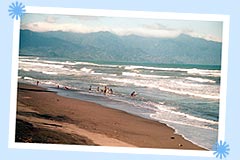Inquirer News Service - August 22, 2003
OUT THE WINDOW
Road Tripping
to the Pacific's Edge
Castillo elected majority leader
By Tals Diaz
PDI Central Luzon Desk
WOW Baler
 Three hours through the mountains and we finally reached our isolated
destination, beautiful, beautiful Baler. I sounded like a broken
record for a D.O.T. ad campaign, because all I kept saying was, "Wow." We
stopped at Sabang beach. Imagine a long strip of clean, unravaged
shoreline embraced by cloud-covered mountains. Jagged islands were
shadows in the horizon of a calm blue sea. Dragonflies gliding
about over blooming purple flowers only breathed more life into
the vision. It's no wonder that Baler was the last pocket of resistance
of the Spanish forces in the Philippines during the Revolutionary
days, clocking in a record year of opposition between June 27,
1898 to June 2, 1899. Hell, if I were one of the Spanish soldiers
then, I'd also fight to my last tooth and rotting nail to keep
this little corner of the Pacific!
Three hours through the mountains and we finally reached our isolated
destination, beautiful, beautiful Baler. I sounded like a broken
record for a D.O.T. ad campaign, because all I kept saying was, "Wow." We
stopped at Sabang beach. Imagine a long strip of clean, unravaged
shoreline embraced by cloud-covered mountains. Jagged islands were
shadows in the horizon of a calm blue sea. Dragonflies gliding
about over blooming purple flowers only breathed more life into
the vision. It's no wonder that Baler was the last pocket of resistance
of the Spanish forces in the Philippines during the Revolutionary
days, clocking in a record year of opposition between June 27,
1898 to June 2, 1899. Hell, if I were one of the Spanish soldiers
then, I'd also fight to my last tooth and rotting nail to keep
this little corner of the Pacific!
Feeling like Lonely Planeteers, we explored the other unspoilt,
idyllic secrets of Baler. We drove languidly to another cove
called "Charlie's Point," otherwise known as the spot
where they filmed the surfing scene for the Francis Ford Coppola
classic, "Apocalypse Now." Another short drive-away
took us to a lush mangrove beach, where we walked through spaces
between the long-stemmed plant life, and marveled at the thriving
population of hermit crabs, mud skippers and spindle stars speckling
unmarked paths to a jagged rock jutting out to the ocean. To
call it paradise would be improper, for "paradise" connotes
unreachability and a sneaky, disturbing feeling of being banished
soon.
No, I would call it a dream, a beautiful, surreal dream we were suddenly immersed
in, feeling as if we were sitting at the edge of a forgotten world.
I Came,
I Saw, I Conquered
Driving through the narrow roads of the quaint little town of Baler was also such a pleasant experience, being greeted by the friendly locals who could spot Manileños from a mile away. We stopped at the town's center where colorful stalls were out in full force. A row of small bahay kubos were decorated with rainbow-colored hats and banigs, accented with bright-yellow coconut clusters hanging from the wooden props. With only 20 pesos, I was able to savor a full fare of isaw, ube ice cream on bread, "cotton candy" sprinkled with powdered milk, all downed with pineapple and sago pampalamig. I saw a man reading a newspaper that was two days old, because they were so isolated that news of the outside world takes more than a fortnight to reach their little community. I thought that the world could have changed drastically within those two days but no one in this happy town of simple pleasures like two-peso isaw could have given a damn.
